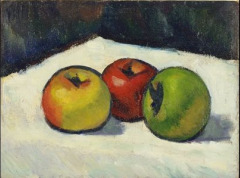 If Montclair Art Museum really thought it was taking a big risk to mount Cezanne And American Modernism, the most ambitious, most expensive exhibit in its history, it may develop a taste for gambling.
If Montclair Art Museum really thought it was taking a big risk to mount Cezanne And American Modernism, the most ambitious, most expensive exhibit in its history, it may develop a taste for gambling.
The show, which ran from Sept. 13 through Jan. 3 (a little less than four months), “far exceeded” the museum’s projections and expectations. Some 30,000 people attended, plus 10,000 in school and adult groups, for a grand total of about 40,000. That was about 360 people per day, on average, vs. a pre-show “push” goal of 190 per day.
 The museum’s previous record for an exhibition was 12,000 visitors, plus 5,400 in groups, for Reflecting Culture: The Evolution of American Comic Book Superheroes, which ran for six months in 2007-08.
The museum’s previous record for an exhibition was 12,000 visitors, plus 5,400 in groups, for Reflecting Culture: The Evolution of American Comic Book Superheroes, which ran for six months in 2007-08.
The Cezanne crowd was geographically diverse, says museum director Lora Urbanelli. About halfway through the show, the museum had already clocked people from “900 different zip codes,” from states including Connecticut and Maryland.
Better yet, Montclair’s membership grew 15% during the Cezanne show. Enrollment in the museum’s classes also climbed, and “we set shop records every week,” Urbanelli said.
In fact, she continued, “Cezanne did so well that we brought everyone back to a five-day work week early, in December.” The museum had put staff on a four-day work-week to save money last spring, and at the time Urbanelli warned them that the cutback might last until June of this year. We can all thank Cezanne.
The show (which I reviewed favorably for the Wall Street Journal here) may yet add more to Montclair’s coffers: It is traveling to much bigger Baltimore, where it opens at the Baltimore Museum of Art on Feb. 14, and later to the Phoenix Art Museum, also bigger.
It’s great that Montclair residents — and many others — proved they will turn out for good art, and maybe that they prefer good art to pop culture exhibits. Yes, Cezanne was the draw, but the exhibit contained many more pictures by Americans (like Morgan Russell’s Three Apples, left) than paintings by Cezanne (his Five Apples is on the right), of which there were eighteen.
Urbanelli acknowledges that it is now her challenge to capitalize on the new interest. “We have a responsibility to keep as much energy going, not with blockbuster exhibits necessarily but by creating excitement and interest. We got people in the door to see Cezanne and they learned about Hartley — so we can surprise them. I am thoroughly convinced that we have to think big if we want to survive — and to think differently.”
Amen.
I’ve written about this exhibit here twice before, once a Five Questions for curator Gail Stavitsky (here), and once elaborating on the WSJ review (here).
